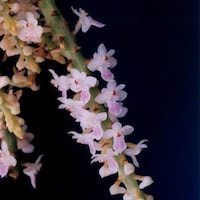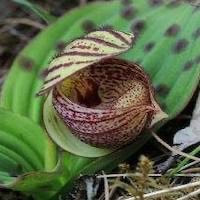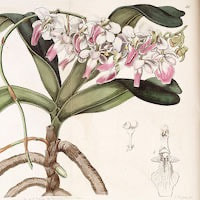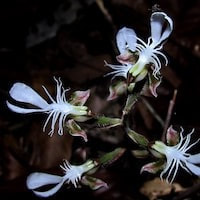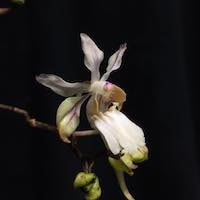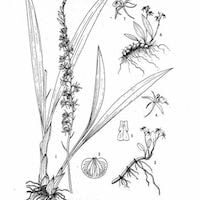MWD9- Men's Woody 9 - Love tonic
|
Native Singaporean Orchid notes: Sobennikoffia Humbertiana
Sobennikoffia humbertiana, known as Sobennikoffia, is a rare orchid species native to Madagascar, thriving in rocky environments within seasonally dry evergreen forests at elevations of 400 to 1200 meters. It relies on morning dew for hydration during certain times of the year and blooms typically in April and May, with flowers noted for their moderate longevity and spicy fragrance with hints of sweet honeysuckle. Selected for its unique scent, Sobennikoffia was featured in the Woody 9 (Men) Team building Perfume workshop, reflecting its significance in orchid studies. Conservation efforts by organizations like the National Parks Board of Singapore (NParks) are crucial to safeguarding rare orchids like Sobennikoffia through responsible and sustainable practices.
|
Therapeutic Orchid notes:
|
Smitinandia micrantha (Lindl.) Holtt.
Smitinandia micrantha, known as Gai hou lan in Chinese and Khem Nu or Kulap dong in Thai, is an orchid that blooms at different times throughout the year across various regions. It flowers from May to July in Nepal, April in China, nearly year-round in Thailand, and from April to May in Perlis, northern Peninsular Malaysia. In traditional herbal practices, the powdered plant is mixed with rice flour and butter to create a tonic in Nepal. Its leaves are used to treat rheumatism, and the juice from its roots is applied to cuts and wounds for healing purposes. |
|
Cypripedium margaritaceum Franch.
Cypripedium margaritaceum Franch., also known as Banyeshao Lan in Chinese or Lanhuashuangyecao in Chinese medicine, is an orchid used in traditional Chinese herbal medicine for its believed health benefits. It grows in shaded areas with its leaves spread horizontally on the forest floor. Traditional uses include nourishing the liver and kidneys, regulating qi and blood flow, promoting diuresis, relieving edema, and improving vision, particularly for night blindness. In Yunnan, China, it's widely used as a folk remedy, prepared by boiling dried herb in water. Scientific research on its medicinal properties remains limited, necessitating further study for validation. |
|
Aerides crispa Lindl.
Aerides crispa Lindl., also known as the Aerides orchid or children of the air, is an epiphytic species native to the Western Ghats in India. Its name reflects its epiphytic nature, growing on trees without deriving nutrients from them. This orchid features robust growth with purple-spotted young leaves and drooping inflorescences up to 35 cm long. In traditional Western Ghats medicine, it's used to make ear drops for treating earaches, prepared by boiling the plant in neem oil. These drops are believed to relieve pain possibly due to the bactericidal compound aeridin, which has antibacterial properties. However, scientific research on its medicinal effectiveness remains limited, requiring further study for validation. |
|
Anoectochilus roxburghii (Wall.) Lindl.
Anoectochilus roxburghii (Wall.) Lindl., known as the jewel orchid or "Wanna rajah" in Sri Lanka and "Yaowang" (King medicine) in Taiwan, is a terrestrial orchid with dark velvety-green to purplish-red leaves adorned with golden veins. It's native to East Asia, including China, Vietnam, Myanmar, and Sri Lanka. Used extensively in traditional medicine, it treats hepatitis, hypertension, and various other ailments in Taiwan and Fujian. Active compounds like kinsenoside and beta-sitosterol suggest potential health benefits, including anti-glycemic and anti-inflammatory effects. Despite its traditional uses, further research is needed to confirm its therapeutic efficacy and safety. |
|
Holcoglossum quasipinifolium (Hayata) Schltr.
Holcoglossum quasipinifolium (Hayata) Schltr., known as the pine leaf orchid or green leaf pine, is a semi-terete leaf orchid native to Taiwan, found in mountain ranges at elevations of 2000–2500 meters on oak tree branches. In traditional medicine, the whole plant is utilized for its medicinal benefits. It is valued for its diuretic effects, aiding in increased urine production to alleviate edema and joint pains. It's also used to treat infections like malaria and sore throat, as well as manage bleeding disorders such as irregular menstruation. Despite its traditional use, more scientific research is needed to validate its efficacy and safety for medicinal purposes. |
|
Liparis fargesii Finet
Liparis fargesii Finet, known as small lip sheep ear garlic or Shimi in Chinese medicine, is a cold-resistant orchid found in regions of China like Southern Gansu, Guizhou, and Yunnan at elevations from 300 to 1700 meters. In traditional Chinese medicine, the entire plant is used for its therapeutic benefits. It is valued for its ability to cool the body, especially beneficial for lung-related issues such as tuberculosis, heat-induced coughs, and whooping cough. To prepare it, 6–9 grams of dried herb are boiled to make a decoction, which is taken as a medicinal remedy. |
Other scent note
Scentopia Library Reference ingredient
Labdanum - Check details at Scentopia's scent library
Download the guided mediation that works best with this Orchid fragrance oil
| men_woody_essential_oil_orchi_00009.mp3 | |
| File Size: | 42798 kb |
| File Type: | mp3 |

